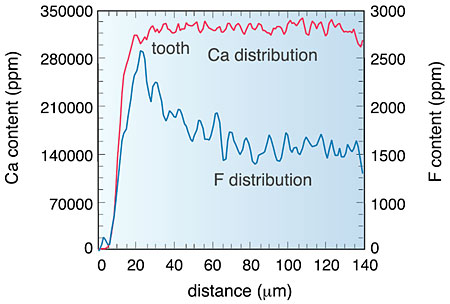We have developed a novel fluorine analysis system with a spatial resolution of 1 micro m using an energetic proton microbeam. This system is expected to be a powerful tool for dental studies.
It is well known that fluorine in teeth has cariostatic properties, so that nearly 70% of commercial toothpastes sold in Japan contain fluoride compounds. However, the optimal fluorine concentration on the surface of teeth for the prevention of caries is still unknown. This is because up to now there have been no analytical methods to study this with good sensitivity, accuracy, and spatial resolution.
The scanning proton microbeam is a promising technique for this purpose, because bombardment of fluorine nuclei with an energetic proton beam causes nuclear reactions which emit gamma-rays. On the other hand, proton beam irradiation of calcium atoms induces only characteristic X-ray emission. The proton microbeam can be focused down to 1 micro m and extracted into an atmospheric environment through a thin organic foil (Fig. 6-11). The photograph of a tooth sample is shown in Fig. 6-12. The combination of simultaneous X-ray and gamma-ray detection in this microbeam system enables a novel fluorine mapping of teeth (Figs. 6-13 and 6-14). This new analytical technique is an in-air, non-destructive method, so that samples can be handled easily and analyzed repeatedly. Observation of the fluorine uptake process is now possible, and further studies promise to reveal the fluorine cariostatic mechanism in teeth.
We also note that the ion-beam-based fluorine analysis system can be employed to find effective materials for prevention of caries, such as toothpaste, mouth rinse, dental materials, and so on.
|


